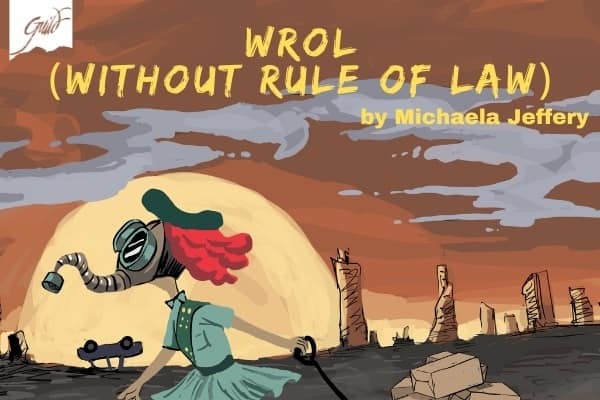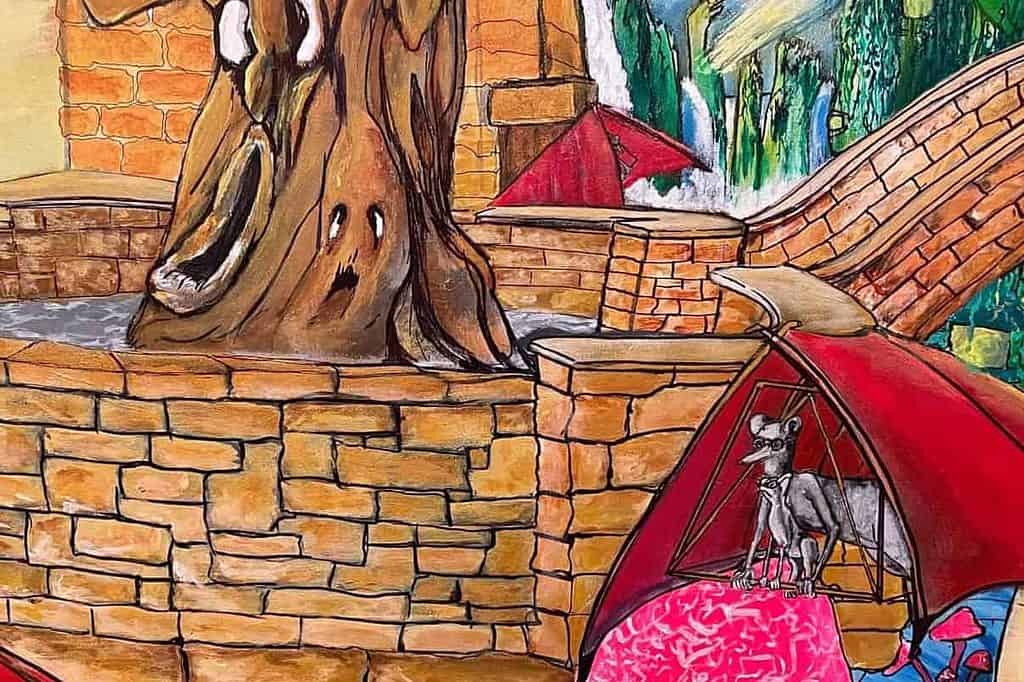As you enter the exhibit They call us Squatters at the Yukon Arts Centre Gallery,four large pieces on the back wall catch your eye with their high contrast.
Each piece is about four feet square. They trace anecdotal images with dramatic light and shadow. The blacks are dark and rich, shaded, inky.
Aha, I said to myself, sunshine coming in a cabin window, the stark shadow inside the dark building. That’s just what they depict.
All four images are set in “Frankie’s shack”. “Ninja in Frankie’s shack” portrays a dog, back to a window, light a halo around its furry edge. Its face is in shadow, its details inside the darkness subtle and tender.
Coming closer, you’ll see the piece is dimensional, layers of felt. The dog comes further forward than the rest of the piece, giving an effect almost of low relief.
“Alison outside Frankie’s shack” is putting her hood up with her eyes down. We can see the wood grain of the cabin’s surface, the darkness inside the windows.
Alison McCreesh is an artist and cartoonist living in the Woodyard in Yellowknife.
The Woodyard has some things in common with our Squatters’ Row here in Whitehorse. Many Whitehorse residents enjoy the “quirks and contradictions of living in a shack five minutes from downtown.”
But the Woodyard exists only because it falls between jurisdictions, into a kind of legal limbo, so residents of the Woodyard don’t have title to their land like the people who live in Squatters’ here.
On the other hand, our Shipyards neighbourhood is now gone, though there are some who still remember it. Woodyard residents have been fighting a similar fate since 1984.
This sword of Damocles hovers over their heads, and lends urgency to McCreesh’s project of documenting what life there is like.
Photo by Alison McCreesh
She does this with a combination of felted word and image. In “Memories of 1984”, a grid of one foot-square panels, two up, includes images of buildings, portraits, people mending a net, a sign that reads “Keep off the Grass” on a snowy mount of overgrown grass, as well as five panels that are just text on colour.
The texts and images read like interviews with people thinking about the Woodyards and the history of their fight to remain there.
On the back wall, McCreesh has installed felted merino wool tubes on pins to create an installation that’s something like an ink drawing of shacks, a bough, a fire pit, and a dog sniffing around off-leash.
It’s close to life size, so you can imagine being there. But it’s more like a drawing than anything else, so it has a drawing’s informality that seems to fit with the neighbourhood feeling McCreesh invites us into.
The exhibit includes a wall hanging timeline 1984-2012, listing titles ranging from “Squatter Policy” to “Draft Harbour Plan”. At the top, a colourful rendition of people and dogs resist a bulldozer.
It’s very interesting to see McCreesh’s wall hanging in the context of Nunavult’s Culture on Cloth, traditional Baker Lake wall hangings next door. Both the artists of Baker Lake and McCreesh use wool to express something about their cultures.
Finally, “My Woodyard”, a grid of small felted rectangles, takes us into life in the Woodyard as if inside McCreesh’s sketchbook.
Simple line drawings that often don’t fill the available space sometimes combine with words. That space fills with her voice.
Here is a skyline, antlers mounted on a wall. A labelled “water truck”. A bunch of hydro lines, with the caption “we’re not really off the grid”. Bicycles, water tanks, boats, the edge of a wood stove—”I keep forgetting the fire”. Tea cup on a table, a leg—”she’s wearing pyjamas under her skirt”.
I won’t tell you any more. Go listen to the voice in them in person, in their own cosy, woolly presence.
McCreesh “reflects on the last little scraps of ‘frontier living’ that remain” in her territory’s capital, and challenges us to consider “what makes our young Northern cities unique.”
Photo by Alison McCreesh
Whitehorse is a good place for this show—these issues are also ours to consider.
It makes me reflect on that fact that since transportation corridors travel north-south rather than east-west, artists or curators from Vancouver are much more likely to be found here than from Yellowknife. Certainly our artists are more likely to visit Vancouver than Yellowknife—it costs a lot less and it’s on the way somewhere.
That’s something of a pity. Whitehorse and Yellowknife are different in many ways, but we share many issues in common, as two small northern capitals not really comparable to cities of the same size in the South.
The world McCreesh evokes for us in these wool pieces is also part of our world, and akin to part of our world that we’ve already bulldozed.
They call us Squatters continues until August 25 at the Yukon Arts Centre Public Gallery, along with Nunavut’s Culture on Cloth by a variety of artists from Baker Lake and Meghan Hildebrand’s Look at all the Things We’ve Found.
Nicole Bauberger is a writer and painter living in Whitehorse. Find out where you can see her work at www.nicolebauberger.com


